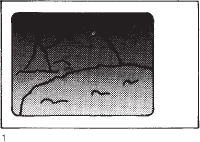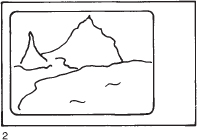The CRT converts the video signal into visual images
Need for Interlace Scanning
This is a convenient time to explain why the interlace scanning method is used in the NTSC (National Television System Committee) television system. Our TV system was developed over 50 years ago. Engineers had to work within the limitations of the time. One of those limitations was the phosphor coating of the CRTs. When the CRT's electron beam struck a phosphor on the face plate, it caused that phosphor to glow. As soon as the electron beam left the phosphor, the glow started to get weaker. If our CRT scanned from line 1 all the way down to line 525 in succession, by the time the electron beam got to the bottom of the picture, the top of the picture would be pretty dark. To prevent this effect, the electron beam scans a field of 262.5 lines and then goes back to the top of the picture. Just as the lines at the top start to darken, the electron beam fills in the spaces between the darkening lines with bright new information. As a result, the overall picture maintains an even brightness. So, the interlace scanning system is the method used to ensure that the picture has an even brightness throughout instead of having separate bright and dark bands.
In addition, there is only so much room for information. This limitation is called bandwidth. You might think of it as how many lanes there are on the highway or how big the water pipe is. The highway and pipe determine how many cars or how much water can be carried. In the TV signal, if we tried to scan 525 lines in sequence one after the other (line numbers 1, 2, 3, 4, 5, 6, ...) for 60 frames, it would take more bandwidth than was available. With today's technology it is possible to design systems that scan lines in this way. This type of scanning is called progressive scanning. In fact, engineers would prefer to do this because it eliminates some problems created by interlace scanning. However, all current TV sets would be incompatible with such a system. As a result, we still use interlace scanning. This will change in the future. New technologies to be discussed later in this book will allow TV sets to display either interlace or progressive scanning.
1. TV without interlace scanning.
2. TV with interlace scanning.


